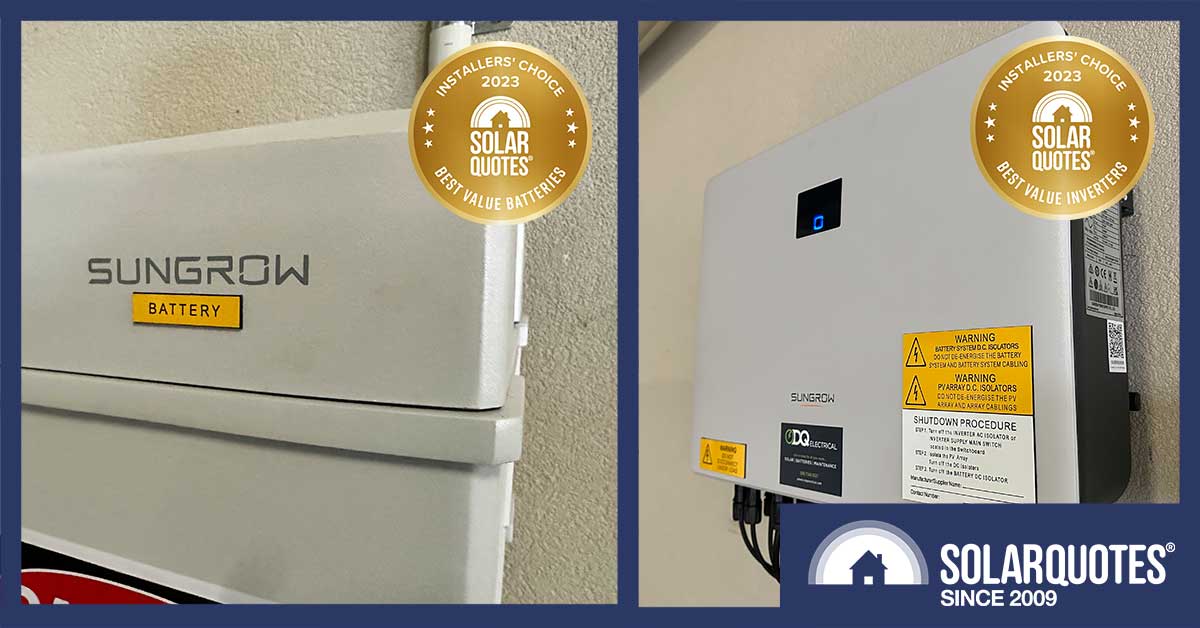
Sungrow inverters and batteries are a popular choice for Australian solar systems thanks to their proven performance and accessible pricing. I thought I’d take a closer look at what makes Sungrow inverters such great value, along with some of their limitations.
Sungrow Inverters – Overview
So, why are Sungrow inverters so highly regarded despite their low price point? What makes them better than other budget inverters? In short, it’s about having a solid foundation; i.e., 10 years of reliable grid connect inverters in Australia with a good technical support service to match.
However, there have been a few issues with Sungrow hybrid inverters and batteries recently that have made some installers a bit gun-shy.
I know firsthand of a battery hybrid that is performing inconsistently, and I’m aware of another that needed three visits and several warranty components to eventually find the source of the problem. Of course, installers with problems will always squeal pretty loudly, so I expect the disquiet I’ve heard is probably not happening on a massive scale.
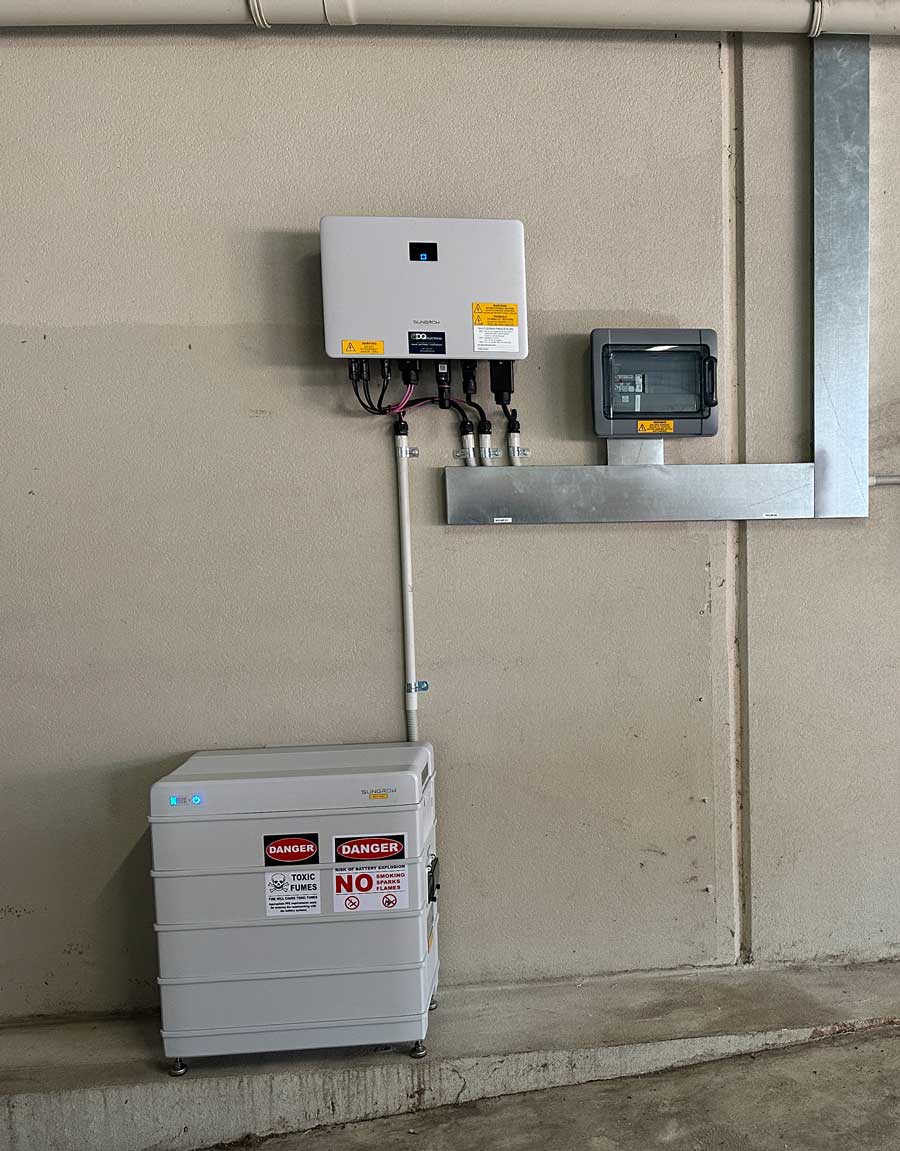
12.8 kWh of Sungrow battery (4 modules) and a single-phase Sungrow hybrid inverter. This one’s owned by Finn.
Sungrowing Pains – The Price Of Success
From what I can gather, Sungrow has enjoyed enormous success recently, but this success has come with some growing pains. With multiple new and inherently more complex battery hybrid systems being rolled out, there will always be glitches and failures. Success also means Sungrow will need more people to answer phones, troubleshoot and deal with new installers doing their first job with unfamiliar equipment. But these relatively small issues are to be expected and should be temporary.
When I recently asked around about what installers want from batteries, my informal poll resulted in Sungrow ticking all the boxes with 27% of installers – almost double that of perennial favourite, Tesla. This was far and away the greatest single block of votes (42), with another 9% going to the option entitled “it just has to work and not cause callbacks”. So, it’s not hard to draw the conclusion Sungrow already has a solid reputation for reliability.
I’ve certainly had a good run with the earlier generation of low-voltage hybrid machines that still had a basic screen to program them. I expect they’ll soon have the more advanced units up to the same high standard, once we’ve done the umpteenth firmware update and got it back online. Again.
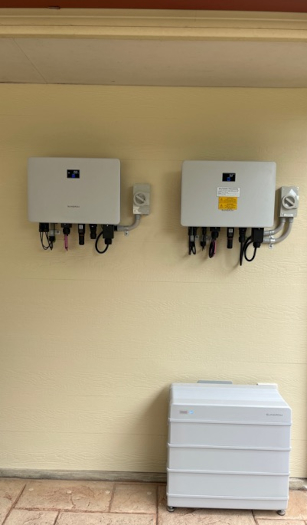
Hybrid and AC coupled solar inverter, with a mess of plugs to terminate them.
Other Features Of Sungrow Inverters
Sungrow offers a good monitoring platform, and it’s readily commissioned provided you remember to set them up on the Australian server; because that’s a trap for young players. The warranty is also good, which we’ve already looked at in detail in our deep dive into Sungrow inverter warranties.
Sungrow batteries also deserve a special mention as really well-resolved, easy-to-handle, modular packages. There’s a robust alloy casing with fast, foolproof connections, meaning you’ll have the ability to grow your capacity incrementally.
The WiFi access isn’t terrible, insomuch as they have a standard dongle that’s not hard to set up, as well as an optional 4G unit that accepts a SIM card for mobile access – meaning you don’t need local internet service. However, the dongles only have a two-year warranty, which I consider a rort, having had to drive a four-hour roundtrip to replace one.
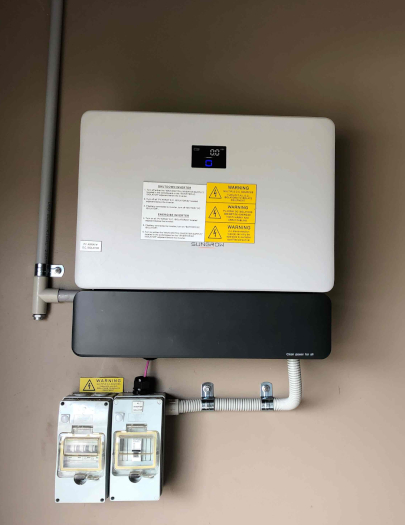
Now with much-needed cover to neaten up the wiring.
Another good thing about Sungrow’s inverter lineup is the option to choose from several capable hybrids – including 3-phase hybrids – so there’s a Sungrow inverter for (almost) everyone.
Finally, the ability to have 20kW of solar on a single-phase property is worth mentioning.
How to install 20 kW of solar on a single-phase property
With AC coupling available for more solar on backup circuits, it’s now possible to install a 5kW hybrid and 5kW standard inverter and then add 20kW of solar panels on the roof of a single-phase property in most of Australia – something unheard of just a few years ago.
The standard single-phase smart meter is also a single pole device with a CT coil. That’s a nice compact unit to put into ever more crowded switchboards, unlike the CHiNT whole current unit for 3-phase applications. Perhaps the best option to be announced recently is a smart meter with external coils that will measure other legacy solar on the premises. This helps the Sungrow monitoring platform display data correctly instead of confusing itself and the end user.
So, What’s The Catch?
All this extra capacity on the backup circuit masks a small problem. Hybrid backup circuits are limited to the throughput rating of the inverter, regardless of if there is grid power available or not. The inverter doesn’t have a higher “pass through” rating when grid-connected, so whatever is on the emergency circuit is effectively throttled by the inverter.
It’s not a problem for the average single fridge and lights scenario, but this limited capacity means the backup circuit can struggle with high inrush loads such as induction motors. The motor in an extra fridge, freezers, air conditioners or especially household water pressure pumps will draw up to seven times their running current when starting.
There are workarounds, and savvy installers will alleviate this with a changeover switch or contactor, which can serve a few functions:
- When the power fails, a manual changeover means you have to physically acknowledge you’re running on battery to turn things over to the backup circuit, so you can curb consumption and save the battery.
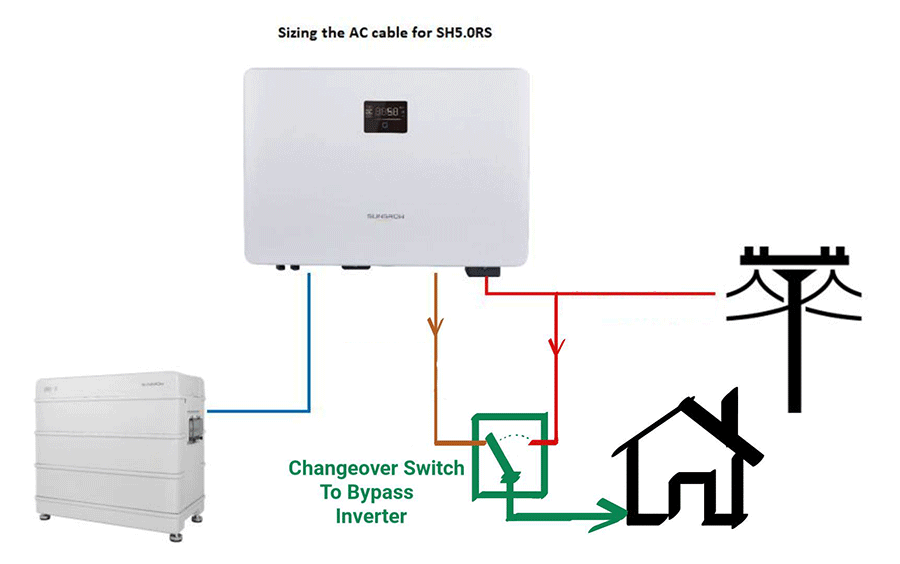
A manual changeover switch bypasses the inverter entirely.
- A contactor can carry large loads as a bypass, which drops out when the power fails and leaves you with essential items segregated at a different sub board.
- A bypass of either kind can offer easily diagnosable troubleshooting over the phone. So, if the inverter fails altogether, power can be restored to ordinary grid supply without tools or expertise.
Hybrid Inverters Need BIG cables
Installers need to be aware of a hybrid’s demands on the wiring. With a combined load of 27A for the backup and a further 30A to force charge the battery from the grid, a nominal 5kW inverter can impose a 13kW load on the AC supply. This means your default rule-of-thumb solar inverter wiring at 6mm² and 32 amps is about half of what’s legally required.
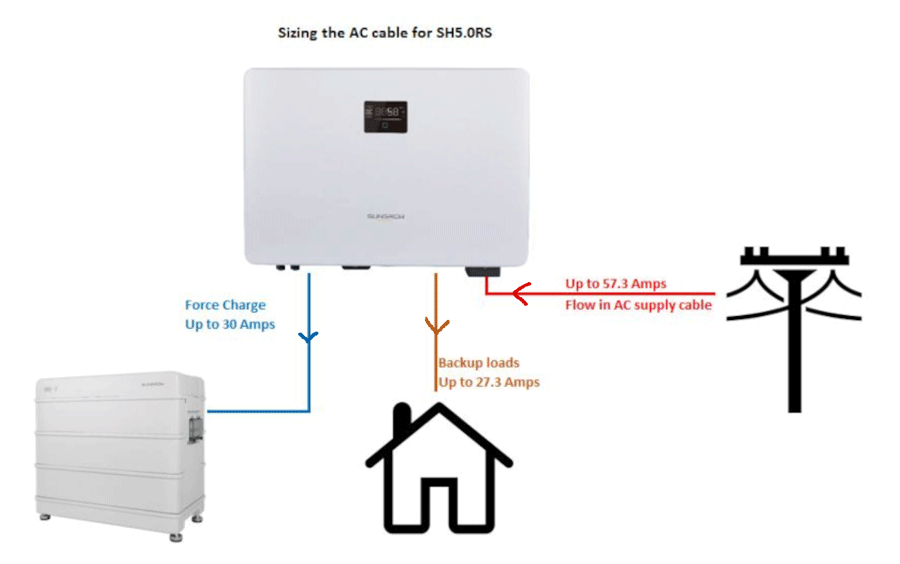
If your breaker keeps tripping since you had a DC coupled battery installed, this might be why. A 57 amp load needs a 63 amp breaker and a 16mm² cable, the same size as many house supplies from the street.
Plugged Connections Are Fiddly
The only other bugbear is plugged connections can be fiddly to terminate, especially when hybrids require very large supply cables that must be broken down into small cables. It’s a trap for some, but really forces you to have just the right flexible cable, the correct bootlace terminations and the right amount of patience to get it all together. In other words, it’s time-consuming but doable.
Sungrow Inverters and Batteries: Great value for money.
Considering you can install a 6.6 kW solar system, a Sungrow hybrid inverter, and 10 kWh of Sungrow battery capacity for about the same price as a single Tesla Powerwall, Sungrow is a compelling proposition for many Australian homeowners. They are (mostly) well-designed and well-supported bits of kit that installers enjoy installing.
Sungrow recently won gold for ‘Best Value Inverters in Australia in 2023‘ and ‘Best Value Batteries in Australia in 2023‘ in this year’s SolarQuotes Installers’ Choice Awards.

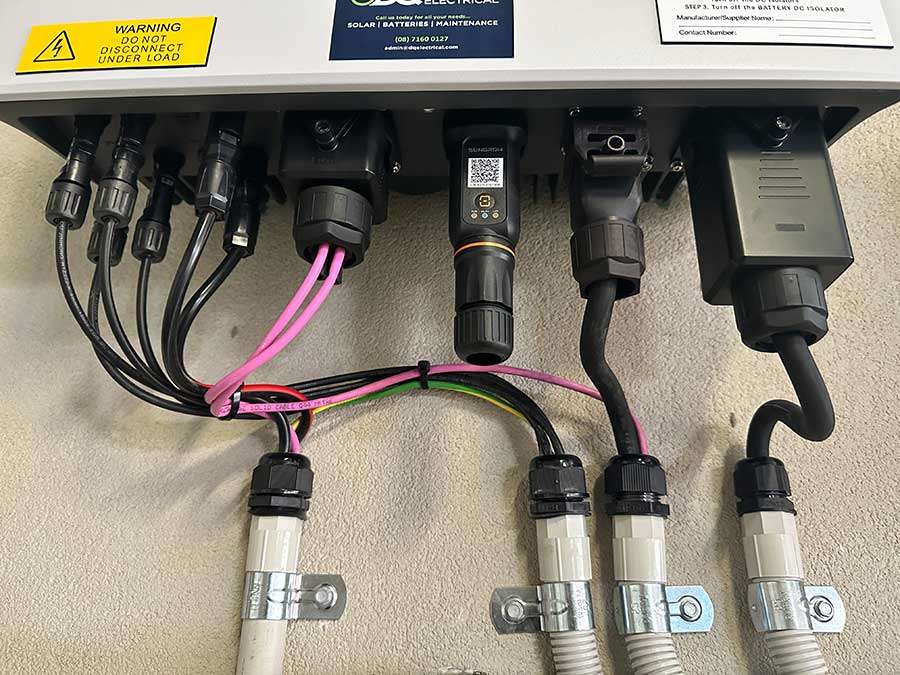
 RSS - Posts
RSS - Posts



Anthony, I have been trying to get this answered but having no luck.
Maybe you can help ?
If i have a manual (or even automatic) changeover switch as you have documented to move my whole switchboard across to the backup circuits in the event of failure – can i run other Inverters (such as a 3 Phase Solis) that i currently have (i.e. will the Sungrow create a microgrid and then managed the power flow from the other inverter whilst still using the 2nd inverters power to charge its batteries ?)
Craig
Hi Craig,
The answer is a qualified yes, but I’m not sure about your Solis.
Sungrow and GoodWe are both offering hybrids which will cope with AC coupled solar on the backup side. They’re effectively becoming a grid forming machine where the additional solar capacity will augment the somewhat limited backup circuit.
However I don’t know if they’ll manage a “generic” inverter with frequency shift like an SMA Sunny Island does. I’m sure you can have a Sungrow Hybrid with and equal or smaller size AC coupled Sungrow in parallel, and I would expect using the same brand equipment with an active communication link for closed loop control is the better way in any case.
Might be worth engaging an installer for a site visit to check the cable sizes in your existing install, establish where things can go and make sure you can get a comms cable installed.
They can be grid forming for any 3rd party inverter of the same or lesser capacity, they don’t need to be configured in master/slave configuration. Excellent inverters and great value.
Gotta say, so far I’m liking my two Sungrow SG5.0RS 5kW inverters.
the iSolarcloud app is great to see at a glance just how much power you’re producing in real time – i’ve produced 1.23MWh in just under 4 weeks that they’ve been installed, and right now, my 13.3kW of panels are producing just under 7kW..(autumn day, central coast, slight cloud and near 3PM)
The inverters also pull into ‘home assistant’ via 3rd party plugin quite well
Howdy.
Re “The inverters also pull into ‘home assistant’ via 3rd party plugin quite well”
Have just read a little about HA, and Solar Edge.
Didn’t see Sungrow mentioned as part of the suite of products it could interface with.
Could you explain please, what the 3rd party plug in is, how it works, and anything else you are kind enough to share.
Cheers
Ive stopped installing Huawei and now exclusively install sungrow or Solar Edge. Stuff being asked to rip them out in 3 years.
While we’re on the subject of Sungrow, can somebody please advise me if their batteries will work satisfactorily with my Fronius Primo inverter?
Yes, you can install a Sungrow hybrid inverter and battery with your Fronius Primo but will need an installer that knows what they are doing to make sure it is set up in a way that is compliant with your local distributor and sets the monitoring up so that you can see the production of both inverters and the discharge of the battery on the one app.
yes, but it will be AC-coupled.
“I know this one anecdotal inverter-battery that is working inconsistently. ”
The structuring of this article is so ridiculous.
No rational person that works in this industry would even mention” oh I know of 1 inverter battery. Total hit piece.
Like who the hell at fronius/solaredge or emphase told you to write this article like this.
So can you tell me how the battery is, I have s systems. 1 is 5.2 and the other is 6.6 both with 5kw sungrow inverters. How much is the battery thanks
I have had the latest Sungrow 5kw inverter installed and a major problem not widely mentioned is how noisy they can be. Mine is installed in the garage and when it’s converting 3.5 to 4.9 kw on a warm day it can become very noisy. Sungrow says it should only be about 35db or similar to a fridge but mine records a loud buzzing noise of 44 to 55db. They won’t replace it saying some noise is normal. My advice is don’t install it where the noise might bother you or your neighbours or chose a different make of inverter.
Brian,
I’m glad I’m not the only one having this outrageous noise problem with a Sungrow inverter. I have just had a Sungrow SH10RT installed at my place. It’s in my garage workshop where temperatures are low and and not exposed to the weather. Perfect location according to installer. Once the output gets over 3 kw it starts a high-pitched whining that exceeds 60 db. That’s equivalent to having a small vacuum cleaner running next to your ear non-stop. If I want to be in my workshop during the day I have to wear ear protection! Ridiculous. Sungrow’s specs on this inverter says 30db level is “typical”. The installer’s first response was “You should have gone with a Fronius!”. Great hearing that now i have Sungrow installed. Is this worth a warranty claim?
Did you ever get this resolved? We’ve just had one installed and it’s doing the same thing. It’s on our balcony which means we would never be able to sit out there on a sunny day, the noise is horrible.
Hi Kat, neither the installer or Sungrow could ever resolve this but a few weeks ago it just suddenly stopped making the whining noise. Don’t know if it was an automatic firmware upgrade or just the inverter “wearing in”, but it’s all fine now.
Tim
Did you ever get this resolved? We’ve just had one installed and it’s making an awful high pitched whine at about 55db.
Hi. Please can you tell me if/where I can get the cover to hide the wiring for the 5Kw inverter. Thanks Mark
You can definitely buy inverter covers, I just had 2 installed and they look great, Perfect cover for protection mainly if inverter is in the sun.
covermyinverter.com.au
or sunnycovers.com.au
Can a Sungrow SH10RT with a Sungrow battery (say 12.8kWh) be able to do a whole house backup or is it only for the backup circuits?
Trying to understand what happens in the scenario when the grid is down during the day where the sun is shining and solar is producing – will the system be able to power the whole house or only the specified backup circuits?
A qualified yes. The manual says SH10RT backup circuit should not exceed 3.33kW per phase. This means some significant thought needs to go into the wiring of the backup circuits. I have two SH10RT’s in master slave and have taken a great deal of time and expense in getting the wiring set up to handle nearly all the house complete with manual cut-over to mains or off for each inverter backjup circuit just is case of inverter failure. I could have made it whole house but decided to leave out my 3-phase AC due to possible inrush current. I initially had the AC on the backup circuit but later removed it just in case. To do all this I monitored pretty much every device in my house for load, checked the loads back at every RCD/Breaker and came up with wiring a plan for my installer. It all works well.
Hi, I have a 8kw sungrow inverter with 9.6kwh battery, I’ve had the rcbo and backup circuits trip twice as well as inverter breaker since installed 3 months ago, both at cloudy times, so wouldn’t think it was overloading, should the installer have used a mcb instead of an rcd for the battery backup and eps?
Hi Tony,
I have a Sungrow 5.5 system that’s very similar to the ones in the photos above.
I have 3 batteries at the moment and have ordered a 4th. as a storage buffer for a series of dull days.
Is it possible to shift the system onto the grid to preserve the SOC of the batteries and prevent them going flat before the system goes to grid?
Is it ok to let the batteries go flat?
Do they retain a minimum charge before switching back to the grid should air conditioning and/or car charging deplete them?
Thanks,
Phil,
AU.
This seems to have gone through to the keeper.
Yes, the SBR series battery [with hybrid inverter] does retain what Sungrow have called a “hidden reserve”, about 5% SoC. So you don’t get the 100% capacity or 100% depth of discharge Sungrow state in marketing and datasheet.
You can preserve the SoC% at any time by “force charge”. Here you set start amd end time of charge and the SoC% you want to charge to. If you set this to the current SoC%, it will maintain it there and loads will be powered from grid.
You can also set an offgrid reserve SoC%. This is then only used if the grid is down.
Ps, I can’t imagine the system “cares” what the nature of the load is, 20 x 100W incandescent bulbs or an air-conditioner or EV. Obviously the battery will deplete quickly with that level of load.
A strategy i use is to either set a very high off grid reserve or a force charge at whatever level I am happy for battery to discharge to, when I want to charge EV overnight. I prefer the latter. But dont forget to disable when done, otherwise will force charge every night.
Greetings All
I recently had a 15 KW Sungrow Inverter install SH15T with 19kw of panels. Sungrow supports whole home backup without a battery so if the grid fails during the day your home can be powered by the PV array. But nobody seems to wire them using the load port in the inverter to support this feature. Has anyone had their Sungrow installed like this?
We have 19kw of panels so even on a cloudy day we produce more power than we need, so the risk of appliances dropping out is minimal if the PV array current drops too low. I can protect sensitive devices (eg computer) with a small UPS as required.
Any idea what is involved in requiring the inverter to suit this functionality?
Hi Peter,
Aside from Fronius offering a dedicated “PV point” backup supply (which would be good to charge a UPS or other battery devices) I don’t know of any other makers offering a decent stable “battery-less” backup solution. It’s very hard to make it stable and even Enphase couldn’t make it work properly so they abandoned the idea.
https://www.solarquotes.com.au/blog/enphase-sunlight-backup/
The catch is obvious (correct me if I am wrong): Sungrow single phase inverters are only compatible with Sungrow batteries and Sungrow batteries are only compatible with Sungrow inverters. Once you get into that ecosystem there is no way out.
Hi Gate,
The real trap is that Sungrow don’t offer an integrated car charger.
The Sungrow EVSE [AC and DC] seems to be available in Europe and UK. If correct, any idea Anthony what problem is for Australia getting the AC model?
I am extremely disappointed with Sungrow’s underhandedness with bs 100% usable and DoD in its battery data sheet but would still leap at Sungrow EVSE that truly integrated with my system.
My zappi…charging from grid doesn’t register at all on Isolarcloud, and charging from solar is registered as export to grid.
Seems to me the Sungrow CT might need to be moved slightly, or the zappi is wired to a wrong point in the circuit because it isn’t treared the same as pool pump, hws, etc
A bright spark who is trying to sort it out said ” it is being exported, but is diverted to the ev.” Go figure. Doesn’t fill me with confidence.
Hi Neil,
Buggered if I know why Sungrow aren’t releasing EVSE equipment here sorry.
Word is there could be something in time for solar xmess (AllEnergy Conference in Oct)
It’s not unusual to have a car charger outside the solar system monitoring but CatchPower might have a good solution to give you integration on everything?
https://www.solarquotes.com.au/blog/ev-draining-home-battery/
Might be true Gate. But once one is in there there is no reason to leave other than inverter or battery failure outside warranty period. What would chances of ALL battery modules failing?
By the time either comes to natural end of life, the other likely to be superseded by technology to I would imagine.
I say this most chances I get these days, but if you’re doing detailed RRT analysis and comparison with other systems, remember, the Sungrow. SBR series battery capacity is NOT 100% usable and 100% depth of discharge is NOT achievable. And I see they’ve continued this with the newer SBH series. Likely to be fantasy there too I suggest.
Like all others, except they are honest about it, there is a 5% reserve that Sungrow will tell you is “hidden” ; tell you AFTER you buy it and question why you’re not getting the full rated kwhs from a new battery.
“Hidden” alright. Hidden from prospective buyers.
Apols for the fat thumb typos
After a long search for a single phase hybrid inverter with 3+ MPPTs I came across Goodwe EHB Series and GW9.99K-EHB-AU-G11 in particular. Similar to SH10RS specs but uses BYD batteries, which makes installation more future-proof. If Sungrow did not act as an a**hole I would stay with their inverters as my system grows, but after their policy change I rather declare it not fit for purpose.
In my view, Inverter brand is not as critical as a battery brand. In a few years different inverter models will appear that may address my growing needs. The battery is the biggest expense, therefore only those who do not lock me into a brand with which no one else can connect have a place on my wall.
Can anyone comment on Goodwe GW9.99K-EHB-AU-G11? Is it good enough to run from 8+8+6 Jinko Tiger 440W? 2023 BYD doc tells me I can have up-to 8 battery modules, and I hope at least 2 stacks in parallel?
That was not my immediate concern Anthony, but thank you for brining that to our attention!
I’ve got into Sungrow by accepting what installer suggested, but with 8+8+6 strings with some 10 degrees azimuth difference what choice do I have except SH10RS? The house is 3 phases but with a hybrid inverter 3 phases is a burden?
At the time of installation Sungrow was supporting BYD batteries. When it came to battery installation they support no more. Can I trust those guys not to move goalposts when they have a better grasp of me with Sungrow battery installed?
I am tempted to throw their inverter away and replace it with anything that supports BYD batteries, but do not see a single phase inverter to support 8+8+6 strings. Besides, when Googling for a Fronius inverter, I came across their AI telling me that Fronius may be so noisy that neighbours offered to pay for a replacement. I don’t really want to listen to 2 of those, especially when I want to expand my system eventually.
Hi Gate,
Just on the noise, Fronius snap inverters did make some fan noise when operating at full steam, however the current generation of hybrid, the Gen24, uses a much bigger heat sink with a much bigger and slower fan.
The fan is there for a reason and it’s really not that noisy.
Hi, im from italy, i have an sh5.0rs and before buy the battery a would know if i can go in backup mode without grid in my country. Without grid (now without battery) i have an error e09, i fear after install battery i should have the same problem. i would be sure of to use the backup line in my country. thanks
I’ve just installed a Solis 3 phase S6-EH3P10K-H inverter with 12kW of PV and a 25kWh battery. This has a 10kW AC backup port.
From what I can see the Solis connection to the main house load does not pass through the inverter, there is merely a set of CT clamps and a meter so the inverter can figure out what is happening at the grid interconnection point. (probably similar to Fronius although they measure internally).
However the loads on the backup port by definition do pass through the inverter so the wiring calcs would need to account for any possible load connected downstream: although in theory limited to 3.3kW per phase, if a changeover switch was fitted then we’re back to what ever switch size was used on the sub board (40A in this case).